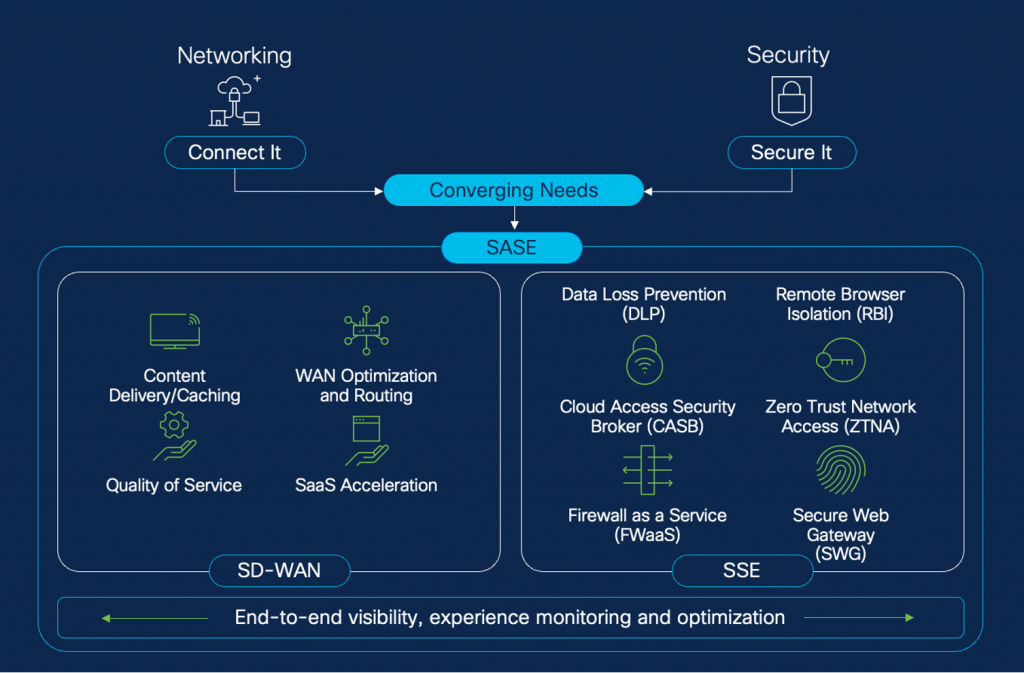Imagine a world where IT isn’t a labyrinth of complexity but instead a streamlined highway to innovation. That world isn’t a pipe dream—it’s a SASE-enabled reality.
As we navigate the complexities of a constantly evolving digital world, a telling remark from a customer onstage with me at Cisco Live in June lingers: “We don’t have time to manage management tools.” This sentiment is universal, cutting across sectors and organizations. An overwhelming 82% of U.S. businesses, according to a Deloitte survey, were prevented from pursuing digital transformation projects because of a lack of IT resources and skills.1 Without the right experts to get the job done, teams are often entangled in complex, disparate systems and tools that require specific skills to operate.
The IT talent crunch
Today’s tech landscape presents a challenge that IT leaders can’t ignore: complex IT needs combined with a fiercely competitive talent market. Internally, teams are overwhelmed, often struggling to keep up with ever-evolving technical demands. In fact, many teams are strapped and rely on early-in-career staff to fill wide gaps left behind by more experienced predecessors. And the problem is only going to get worse.
For experienced IT workers, it’s an attractive time to entertain new opportunities. According to a global Deloitte study, 72% of U.S. tech employees are considering leaving their jobs for better roles.2 Interestingly, a mere 13% of employers said they were able to hire and retain the tech talent they most needed.2
Now more than ever, organizations must rethink their approach to talent management and technology adoption to stay ahead of the curve.
Convergence as a catalyst for transformation
In an era where time is a premium and complexity is the norm, the need for convergence has never been more apparent. Technical skills, while essential, are not enough. The real game-changers are adaptability, cross-functional collaboration, and strategic foresight. And yet, these “soft skills” can’t be optimally used if teams are entangled in complex, disparate systems and tools that require specialized skills to manage and operate.
So how do organizations tackle this dilemma? How do they not just keep the lights on but also innovate, improve, and lead? In a word: convergence. Unifying siloed network and security teams as well as systems and tools with a simplified IT strategy is key to breaking through complexity.
A platform to radically simplify networking and security
Secure access service edge (SASE) is more than just an architecture; it’s a vision for the future where the worlds of networking and security are not siloed and become one. Cisco takes a unified approach to SASE, where industry-leading SD-WAN meets industry-leading cloud security capabilities in one, robust platform to make managing networking and security easy.

(Click to enlarge)
Unified SASE converges the two domains into one, streamlining operations across premises and cloud. Admins from both domains gain end-to-end visibility into every connection, making it easier to optimize the application experience for users, providing seamless access to critical resources wherever work happens. This converged approach to secure connectivity through SASE delivers real outcomes that matter to resource-strapped organizations.
Simplify IT operations and increase productivity
- Administrators find it easier to manage networking and security when they are consolidated
- 73% reduction in application latency improves collaboration and enhances overall productivity3
- 40% faster performance on Microsoft 365 improves employee experience
Do more with less
- 60% lower TCO for zero-trust security enables budget reallocation to strategic initiatives3
- 65% reduction in connectivity costs helps ease the burden on IT budgets3
Enhance security without adding complexity
- Simplify day-2 operations with centralized policy management, which makes it easier for IT teams to execute
- Improve security posture through consistent enforcement—from endpoints and on-premises infrastructure to cloud—across your organization
Scale and adapt
- Cloud-native architecture supports scaling and addresses the challenges of rapidly evolving IT landscapes
- Prepares your organization for changes, reducing the need for constant upskilling or reskilling in IT teams
Organizations can use SASE architecture to advance their technological frameworks and strategically address the IT skills gap, leading to long-term business success.
Shifting gears: Unifying, simplifying, innovating
SASE is not merely a technological evolution; it’s a paradigm shift in how we approach IT management. This lets IT admins focus less on tool management and more on driving business innovation, enriching user experiences, and evolving in tune with market demands.
Figure 2. Introducing unified SASE with Cisco+ Secure Connect, a better way to manage networking and security
The path ahead with unified SASE from Cisco
Cisco offers a unified, cloud-managed SASE solution, Cisco+ Secure Connect. From on-premises to cloud, this comprehensive SASE solution delivers simplicity and operational consistency, unlocking secure hybrid work for employees wherever they choose to work. The beauty of Cisco’s unified SASE solution lies in the principle of interconnecting everything with security everywhere–if it is connected, it is protected. It’s that easy.
Let’s drive the future together—simpler, more secure, and more agile. The time for SASE is now; the future is unified.
Experience how stress-free managing secure connectivity can be with
SASE with Cisco+ Secure Connect
References
1. Tech Trends 2023, Deloitte Insights
2. 2023 Global Technology Leadership Study, Deloitte
3. Cisco research and customer results


Omri, I really enjoyed reading your post – you raised some excellent points about how SASE convergence can simplify IT management and help address the skills gap many organizations face. Your perspective on unifying networking and security to streamline operations and enable innovation truly resonates. As we recently experienced with a major financial client, having expertise to guide organizations through both the technology and human aspects of SASE adoption is so important. Our collaborative engagement with them underscored the huge potential of SASE in transforming IT strategies, just as you highlighted with our Cisco solutions. It’s great to see the shared vision on SASE as an opportunity to simplify IT complexity. Your post provided awesome insights on this paradigm shift. Looking forward to more thought leadership!
#BridgingTheGapWithSASE